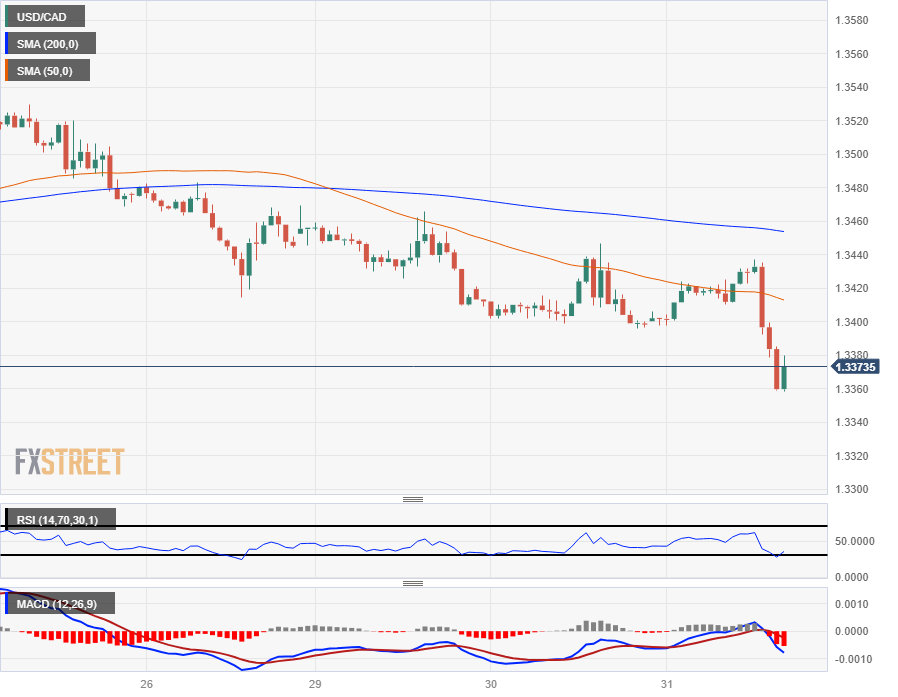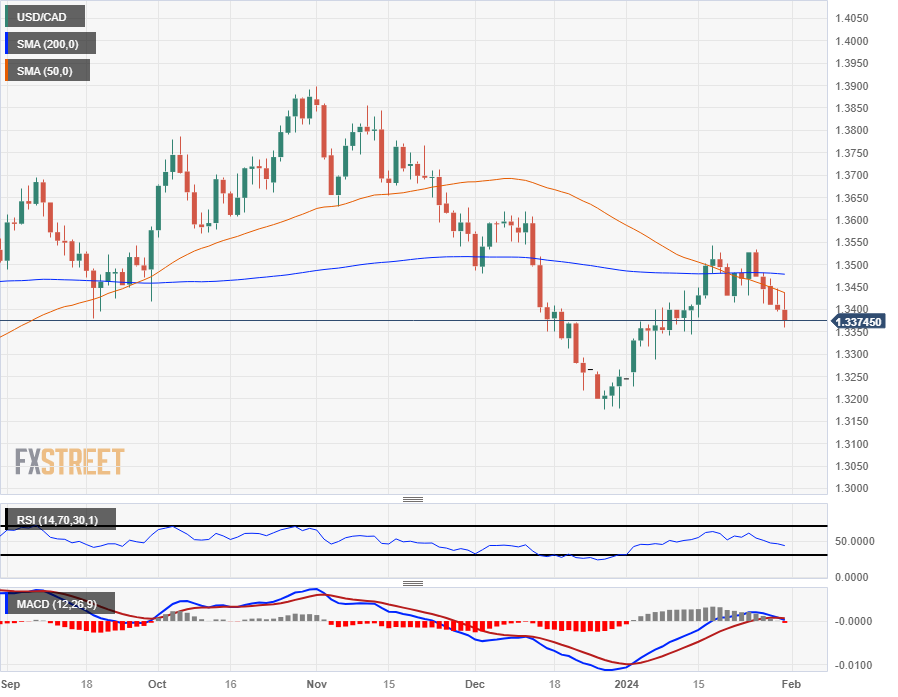- Phân tích
- Tin tức và các công cụ
- Tin tức thị trường
- Canadian Dollar recovers on upbeat Canadian GDP, Fed Powell still in the barrel
Canadian Dollar recovers on upbeat Canadian GDP, Fed Powell still in the barrel
- The Canadian Dollar recovered some ground after GDP surprised to the upside.
- Canada saw 0.2% GDP growth in November, which beat consensus.
- Fed rate call and press conference due in the latter half of the US trading session.
The Canadian Dollar (CAD) edged higher on Wednesday after Canadian Gross Domestic Product (GDP) figures beat expectations to post growth for the first time since May. The Federal Reserve’s latest rate call is due at 19:00 GMT, with a press conference to be headed by Fed Chairman Jerome Powell at 19:30 GMT.
Canada saw growth in its MoM GDP for the first time in seven months on Wednesday, sending the Canadian Dollar into recovery mode against the US Dollar (USD), but the CAD still remains in the red against several of its major currency peers. Loonie traders will be looking ahead to Thursday’s January Canadian Purchasing Managers Index (PMI) figures for Canada’s manufacturing sector after the Fed rate call dust settles.
Daily digest market movers: Canadian Dollar surges against the Greenback on GDP growth
- Canadian November GDP growth was a surprise on Wednesday, coming in at 0.2% MoM versus the forecast of 0.1%.
- Canadian GDP printed above 0.0% for the first time in seven months after revisions.
- S&P Global’s Canadian Manufacturing PMI for January is due Thursday, last MoM Manufacturing PMI printed in contraction territory at 45.4.
- US Fed broadly expected to hold rates steady on Wednesday, market focus to pivot to Federal Open Market Committee (FOMC) Press Conference at 19:30 GMT.
- Investors will be looking for hints about when the Fed will cut rates.
- Rate swap bets on a Fed cut in March lurched higher early Wednesday, now pricing in 65% chance of at least a 25 basis point rate trim by March 20 meeting.
- The US Dollar backslid after ADP Employment Change figures came in well below expectations and an unexpected backslide in the Chicago PMI.
- ADP Employment Change in January fell to 107K versus the forecast for 145K, December’s 158K (revised down from 164K).
- January’s Chicago PMI declined to 46.0 instead of the forecasted uptick to 48.0 against December’s 47.2 (revised up from 46.9).
- Volatile ADP figures are prone to steep revisions and has a sketchy-at-best track record for previewing the US Nonfarm Payrolls (NFP) print slated for Friday.
- ADP Employment Change has seen revisions in all but a single month since 2007.
Canadian Dollar price today
The table below shows the percentage change of Canadian Dollar (CAD) against listed major currencies today. Canadian Dollar was the strongest against the US Dollar.
| USD | EUR | GBP | CAD | AUD | JPY | NZD | CHF | |
| USD | -0.10% | -0.22% | -0.20% | -0.15% | -0.72% | -0.32% | -0.33% | |
| EUR | 0.10% | -0.13% | -0.10% | -0.03% | -0.61% | -0.21% | -0.21% | |
| GBP | 0.24% | 0.12% | 0.00% | 0.09% | -0.51% | -0.08% | -0.09% | |
| CAD | 0.21% | 0.11% | -0.04% | 0.06% | -0.50% | -0.07% | -0.08% | |
| AUD | 0.18% | 0.06% | -0.05% | -0.06% | -0.53% | -0.14% | -0.16% | |
| JPY | 0.71% | 0.62% | 0.47% | 0.53% | 0.58% | 0.42% | 0.42% | |
| NZD | 0.32% | 0.23% | 0.08% | 0.08% | 0.17% | -0.40% | -0.01% | |
| CHF | 0.30% | 0.19% | 0.06% | 0.09% | 0.14% | -0.42% | 0.01% |
The heat map shows percentage changes of major currencies against each other. The base currency is picked from the left column, while the quote currency is picked from the top row. For example, if you pick the Euro from the left column and move along the horizontal line to the Japanese Yen, the percentage change displayed in the box will represent EUR (base)/JPY (quote).
Technical Analysis: Canadian Dollar climbs over the Greenback on Canadian GDP upshot
The Canadian Dollar (CAD) has chalked in some gains on Wednesday, climbing around a fifth of a percent against the US Dollar as the Greenback recedes across the broader market. The CAD is still softer against the Japanese Yen (JPY), the market’s single best-performing currency in the mid-week trading session. The Loonie has shed over half a percent against the Yen for Wednesday.
USD/CAD tumbled to 1.3360 in early US trading, falling 0.6% from the day’s peak of 1.3437. Intraday momentum is dragging the pair back into the 1.3400 handle ahead of the Fed’s policy statement, and investors will be bracing for whips in the USD/CAD.
If the Canadian Dollar achieves a bullish close against the US Dollar on Wednesday, the USD/CAD will etch in its fifth consecutive down day as the pair pulls away toward the downside from the 200-day Simple Moving Average (SMA) near the 1.3500 handle.
USD/CAD Hourly Chart
USD/CAD Daily Chart
Canadian Dollar FAQs
What key factors drive the Canadian Dollar?
The key factors driving the Canadian Dollar (CAD) are the level of interest rates set by the Bank of Canada (BoC), the price of Oil, Canada’s largest export, the health of its economy, inflation and the Trade Balance, which is the difference between the value of Canada’s exports versus its imports. Other factors include market sentiment – whether investors are taking on more risky assets (risk-on) or seeking safe-havens (risk-off) – with risk-on being CAD-positive. As its largest trading partner, the health of the US economy is also a key factor influencing the Canadian Dollar.
How do the decisions of the Bank of Canada impact the Canadian Dollar?
The Bank of Canada (BoC) has a significant influence on the Canadian Dollar by setting the level of interest rates that banks can lend to one another. This influences the level of interest rates for everyone. The main goal of the BoC is to maintain inflation at 1-3% by adjusting interest rates up or down. Relatively higher interest rates tend to be positive for the CAD. The Bank of Canada can also use quantitative easing and tightening to influence credit conditions, with the former CAD-negative and the latter CAD-positive.
How does the price of Oil impact the Canadian Dollar?
The price of Oil is a key factor impacting the value of the Canadian Dollar. Petroleum is Canada’s biggest export, so Oil price tends to have an immediate impact on the CAD value. Generally, if Oil price rises CAD also goes up, as aggregate demand for the currency increases. The opposite is the case if the price of Oil falls. Higher Oil prices also tend to result in a greater likelihood of a positive Trade Balance, which is also supportive of the CAD.
How does inflation data impact the value of the Canadian Dollar?
While inflation had always traditionally been thought of as a negative factor for a currency since it lowers the value of money, the opposite has actually been the case in modern times with the relaxation of cross-border capital controls. Higher inflation tends to lead central banks to put up interest rates which attracts more capital inflows from global investors seeking a lucrative place to keep their money. This increases demand for the local currency, which in Canada’s case is the Canadian Dollar.
How does economic data influence the value of the Canadian Dollar?
Macroeconomic data releases gauge the health of the economy and can have an impact on the Canadian Dollar. Indicators such as GDP, Manufacturing and Services PMIs, employment, and consumer sentiment surveys can all influence the direction of the CAD. A strong economy is good for the Canadian Dollar. Not only does it attract more foreign investment but it may encourage the Bank of Canada to put up interest rates, leading to a stronger currency. If economic data is weak, however, the CAD is likely to fall.
© 2000-2024. Bản quyền Teletrade.
Trang web này được quản lý bởi Teletrade D.J. LLC 2351 LLC 2022 (Euro House, Richmond Hill Road, Kingstown, VC0100, St. Vincent and the Grenadines).
Thông tin trên trang web không phải là cơ sở để đưa ra quyết định đầu tư và chỉ được cung cấp cho mục đích làm quen.
Giao dịch trên thị trường tài chính (đặc biệt là giao dịch sử dụng các công cụ biên) mở ra những cơ hội lớn và tạo điều kiện cho các nhà đầu tư sẵn sàng mạo hiểm để thu lợi nhuận, tuy nhiên nó mang trong mình nguy cơ rủi ro khá cao. Chính vì vậy trước khi tiến hành giao dịch cần phải xem xét mọi mặt vấn đề chấp nhận tiến hành giao dịch cụ thể xét theo quan điểm của nguồn lực tài chính sẵn có và mức độ am hiểu thị trường tài chính.
Sử dụng thông tin: sử dụng toàn bộ hay riêng biệt các dữ liệu trên trang web của công ty TeleTrade như một nguồn cung cấp thông tin nhất định. Việc sử dụng tư liệu từ trang web cần kèm theo liên kết đến trang teletrade.vn. Việc tự động thu thập số liệu cũng như thông tin từ trang web TeleTrade đều không được phép.
Xin vui lòng liên hệ với pr@teletrade.global nếu có câu hỏi.















